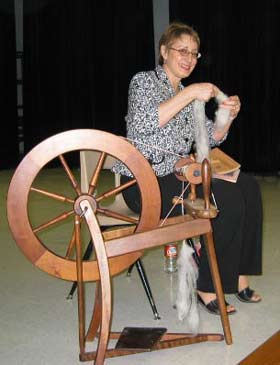 Reader question: What is a “spin doctor”?
Reader question: What is a “spin doctor”?
My comments: A spin doctor is not to be confused with a medical doctor who treats patients to cure them of disease.
A spin doctor on the other hand is someone who “treats” a story (or mistreats it, but we’ll come to that later). He “spins” a story, you see, as in the phrase “spin a yarn”, meaning to tell a long and winding story.
A “yarn” is a strand of thread, long and winding as a result from being spun from, say, a spinning machine. For centuries, though, “spinning a yarn” has also been an idiom for telling a tale, especially a long and winding tale as told by sailors and other seafaring people. As they relate their stories, these people, everyone a Robinson Crusoe, tend to exaggerate over their adventures abroad. Hence, spinning yarns became synonymous for telling fabricated stories, too, that is, stories that might not be entirely true.
Not to stray too far, let’s get back to the term “spin doctor”, who is generally speaking a media relations advisor to a government or a political party or a PR expert hired by a company. The jobs of these people are essentially to “treat” information (to suit their propaganda needs), much in the way a doctor “treats” a patient. Have you ever heard of phrases like a “doctored photo”, for example? That means the photo is not genuine, not the way it originally looks like, but edited. Similarly, spin doctors often purge unfavorable facts and figures from stories to be released to the public.

To do that, they have to “spin”, of course. That is, twist things around, and generally try to “put a positive spin” on anything undesirable happening. They do that by, for example, hiding unfavorable facts while highlighting favorable figures.
That is, so that the story reads like a feather in the cap rather than a slap in the face. That’s how most press releases read, is it not?
Anyways this, for your reference, from Phrases.org.uk: So, why ‘spin’? For the derivation of that we need to go back to yarn. We know that sailors and other storytellers have a reputation for spinning yarns. Given a phrase in the language like ‘spin a yarn’, we might expect to assume that a yarn was a tall tale and that the tellers spun it out. That’s not quite right though. Until the phrase was coined, yarn was just thread. The phrase was coined as an entity, just meaning ‘tell a tale’. That came about in the early 19th century and was first written down in James Hardy Vaux’s A new and comprehensive vocabulary of the flash language, in 1812: “Yarning or spinning a yarn, signifying to relate their various adventures, exploits, and escapes to each other.” So, spin became associated with telling a story. It began to be used in a political and promotional context in the late 1980s. For example, in the Guardian Weekly, January 1978: “The CIA can be an excellent source [of information], though, like every other, its offerings must be weighed for factuality and spin.” From there it is a small step for the people employed to weave reports of factual events into palatable stories to be called ‘spin doctors’.
文仅代表作者本人观点,与本网立场无关。欢迎大家讨论学术问题,尊重他人,禁止人身攻击和发布一切违反国家现行法律法规的内容。
About the author:
Zhang Xin is Trainer at chinadaily.com.cn. He has been with China Daily since 1988, when he graduated from Beijing Foreign Studies University. Write him at: zhangxin@chinadaily.com.cn, or raise a question for potential use in a future column.
